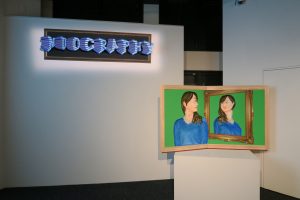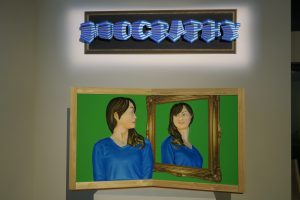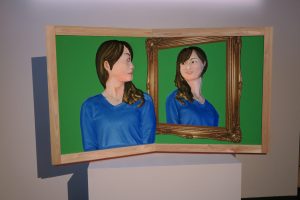我々の目は見る対象を正確にとらえているように思われるが、実は目から入った視覚情報が脳に伝達される過程でゆがめられ、びっくりするような見え方をする「錯視現象」を起こす。そのような目の錯視を利用する3Dイリュージョン(逆遠近錯視)は、「立体的に見える絵画」や「見る角度によって印象が異なる作品」など、不思議で楽しめるアートである。一方、「対称性」は、かつて物理学では普遍的な考えであったが、対称性が破れると“物理の世界”特に“素粒子の世界”では面白い研究対象となっている。ノーベル賞授賞者、D.J. Gross、が述べたように、“自然の秘密は対称であるが、世界の質感は対称性の破壊によるものである”(“The secret of nature is symmetry, but the texture of the world is due to symmetry breaking.” PNAS 93, 14257, 1996)。本作品は、女性が鏡に映った姿と元の自分の姿を3Dイリュージョンで表現してみた。素粒子であるミュオンの対称性/非対称性を美女の“質感”になぞらえたものであって、美女(Angel)か魔女(Witch)かだれにも確実にわからない。Norman D. Cook
It seems that our eyes accurately capture what we see, but our preconceptions about what we observe sometimes cause surprising “optical illusions”. 3D illusions, such as the traditional “hollow mask illusion” and the “reverse perspective illusion” invented by Patrick Hughes utilize the available visual information to produce mysterious and enjoyable art – works that seem to move of their own accord and to produce counterintuitive impressions depending on the viewing angle. On the other hand, “symmetry” is a universal phenomenon in physics, but when symmetry is broken, it becomes an interesting research topic, especially in the world of elementary particles. As noted by the Nobel Prize winner, DJ Gross, “The secret of nature is symmetry, but the texture of the world is due to symmetry breaking” (PNAS 93, 14257, 1996). In this work, I tried to create a 3D illusion of a good-looking woman examining her good looks in a mirror when both she and her reflection are depth inverted. For the observer, the depth inversion is a good “looking experience” because the strangeness of the asymmetry of the 3D illusions makes it uncertain for us whether she is indeed a good-looking Angel or a Witch. Norman D. Cook


